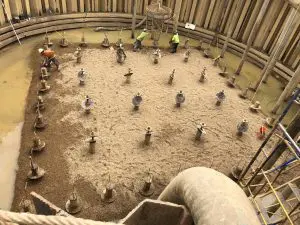
American Deep Foundation, Inc. is a pile contractor established in 1996 with expertise installing nearly all types of drilled and driven piles including micropiles. We are a micropile contractor with extensive experience installing drilled micro piles. ADF can install piles of all lengths and capacities, but is most competitive on projects that have long piles and the more the better. ADF owns lattice boom cranes up to 110-ton capacity and when necessary, rents larger cranes in order to install micropiles in one piece, many times, in excess of 100 feet in length. When the micro piles are installed in a single piece there can be a significant savings in both cost and schedule by saving the time and expense of numerous splices. Although the mobilization of ADF’s large equipment is more expensive than smaller micropile equipment, that cost can be spread over the savings on each pile due to the elimination of splicing costs, reducing the overall cost of the project.
Because of the extended reach of the crane used to install the drilled micro piles ADF does not have to be able to have access for the pile rig at pile locations. Micropile drilling can be done by reaching into a cofferdam, over pipelines, buildings or obstructions or even in a river or lake without dewatering if necessary. On one critical project that was continually flooded due to unusually high river levels ADF drilled and grouted micropiles through 24 feet of water.
Although using the crane, micropile drilling is accomplished using longer initial lengths splicing can still be done when needed. American Deep Foundation has installed micro piles with an initial pile unspliced length of 120 feet and a final spliced length in excess of 300 feet.
The drilled micro pile diameters that ADF typically installs are 7 inch and 9 5/8 inch. Piling material for these diameters is readily available in varying wall thicknesses. For piles with initial installation lengths less than 60 feet the material is typically shipped to the jobsite in the proper length to be picked up and installed. For pile lengths to be installed with initial lengths in excess of sixty feet the piles are spliced on the jobsite using full penetration butt welds that develop the full capacity of the pipe in tension, compression and bending. Nearly any diameter of micropile can be installed by ADF but equipment needs to be specifically fabricated to suit nonstandard sizes.
 Micropiles are not always the answer. When driven piles or augered cast in place piles can be installed to carry the design loads they will normally be less expensive than micro piles. In a geotechnical profile such as one that has sound rock that is overlain with layers of soil as well as layers of rock such as the Karst profile in eastern Tennessee and Western North Carolina, driven and auger cast piles may not reach the necessary bearing stratum. In this case micropiles may be the perfect solution. Micropiles are able to penetrate the upper rock layers that are not sufficiently thick to reach continuous stable rock that is capable of carrying the foundation loads required.
Micropiles are not always the answer. When driven piles or augered cast in place piles can be installed to carry the design loads they will normally be less expensive than micro piles. In a geotechnical profile such as one that has sound rock that is overlain with layers of soil as well as layers of rock such as the Karst profile in eastern Tennessee and Western North Carolina, driven and auger cast piles may not reach the necessary bearing stratum. In this case micropiles may be the perfect solution. Micropiles are able to penetrate the upper rock layers that are not sufficiently thick to reach continuous stable rock that is capable of carrying the foundation loads required.
On many projects, especially in the piedmont, soil conditions vary enough that one pile type is not feasible at all locations. For example, one section of the site might have a continuous very sound rock layer with nothing preventing a driven steel H pile or steel pipe pile from reaching its required bearing capacity on the rock but another portion of the site might have layers of rock not capable of carrying the required bearing capacity above the continuous sound rock requiring the use of drilled micro piles to penetrate the upper layers.
Micro pile Installation Procedure
In a Karst type situation where the upper rock layers are separated by unstable, sometimes zero blow count, material the micropile will need to be cased while drilling to the continuous rock. The drilling is accomplished using a down the hole hammer (DTH) with a bit that extends slightly beyond the bottom of the casing and will expand to cut a hole in the rock slightly larger than the casing diameter. As the pile is drilled through rock and overburden the drill spoil material is blown out the top through a diverter to a suitable location using high pressure compressed air.
As the micropile drilling occurs, a record is kept (typically by the geotechnical engineer) of the thicknesses of the soil and rock layers as well as the time required to penetrate the rock. Based on the rock values given in the geotechnical report the engineer designing the micropiles has determined the depth into solid rock that should be necessary to carry the design loads (tension and compression) in friction of the pile on the sides of the drilled hole. Some soil layers can occur in the rock socket but depending on the conditions soil lenses or voids are usually limited to a cumulative six inches or so.
Once the micropile casing is drilled to the required depth into the continuous rock, any loose material is blown from the casing, the specialty underreaming bit is compressed and the drill stem and drilling tools are removed. The pile casing remains at the bottom of the hole protecting the rock socket until the day the pile is to be grouted.
 On the day the micropile is to be grouted the micropile casing is pulled so that the tip of the casing is six inches to one foot below the top of the rock socket. The casing is then cut off at the proper pile cut off elevation. The micropile grout is pumped into the pile through a tremie pipe placed through the casing to the tip of the rock socket. Micropile reinforcing is installed through the fluid grout immediately after grouting.
On the day the micropile is to be grouted the micropile casing is pulled so that the tip of the casing is six inches to one foot below the top of the rock socket. The casing is then cut off at the proper pile cut off elevation. The micropile grout is pumped into the pile through a tremie pipe placed through the casing to the tip of the rock socket. Micropile reinforcing is installed through the fluid grout immediately after grouting.
In order to verify the ultimate strength of the rock socket per square inch a test pile can be installed with a short enough rock socket that it is expected to be able to be loaded to failure. In this case once the pile is installed with an accurate record of the rock socket depth the micropile can be tested in tension or compression. If the pile is tested in compression, a void form must be installed below the grout in the rock socket to eliminate any end bearing capacity.
Typically, micro piles are not end bearing piles but instead carry the load by friction between the grout in the bond zone beyond the tip of the permanent casing (if used) and the rock surrounding the pile. Micropiles carry lateral loads either by the use of a permanent casing or by using a steel reinforcing cage in the upper portion of the pile. If a plumb micropile is not sufficient to carry the required lateral loads the piles can be battered (installed at an angle) in order to carry significant lateral loads.
American Deep Foundation personnel are always available to provide budget pricing or analysis of the best and most economical pile type for your project. If more than one pile type is suitable, we will be glad to price different options to help with your decision. We are glad to work with your structural engineer or we can provide the services of our engineer and perform the pile scope design-construct. You will be pleased that you selected ADF as your micropile contractor.

